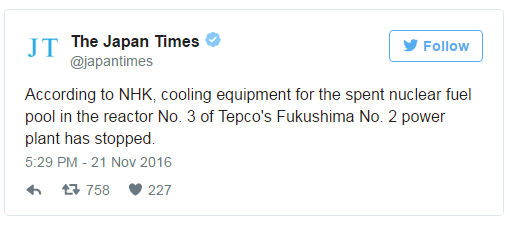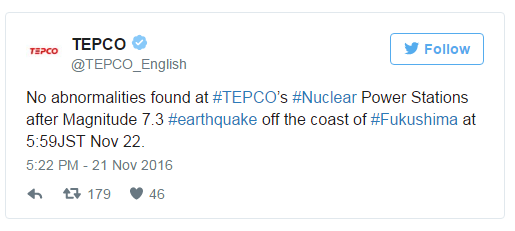As “clean” as nuclear power might be when compared to the use of fossil fuels like coal, there remain a couple big problems. One involves the storage of the spent fuel rods which will remain highly radioactive for perhaps 10,000 years, and must be kept cool.
The other problem is that if there is an accident at a nuclear plant, the results can be disastrous, as radiation is spread for miles creating zones where people will not be able to live and work for hundreds of years. At least not safely.
Japan sits right along the “ring-of-fire” which is that area around the Pacific Ocean that is especially active from a seismological standpoint. In other words, it is earthquake prone. Earthquakes and nuclear power plants are an awful combination as the world saw in 2011 when an earthquake generated a tsunami that wrecked the Fukushima nuclear power plant.
Now another earthquake has hit nearby, and damage has already been reported.
The cooling system of the third reactor at the Fukushima nuclear power plant has stopped circulating water following a powerful 7.3 offshore earthquake. TEPCO said it managed to restart the system some 90 minutes after the failure.
According to the Nuclear Regulatory Agency the cooling system servicing the Unit 3 spent fuel pool is not able to circulate water to cool the nuclear fuel because of a broken pump.
At such a pace, the cooling system failure posed no “immediate danger,” although the agency admitted “gradual” rise in temperatures.
Failure to keep the spent fuel rods cool will cause catastrophic results. Like spreading deadly radiation into the atmosphere, perhaps to a city like Tokyo. Keep in mind that these spent fuel rods can remain dangerous for 10,000 years. Not the sort of thing to take lightly.
Tokyo Electric Power Company (TEPCO) told national broadcaster NHK that the cooling system in the Reactor 3 spent fuel pool stopped working. Japan’s national nuclear agency has confirmed that the temperature rise in the pool is “gradual.” The exact cause of the cooling system stoppage is currently unknown. However, the system might have been “shaken” during the earthquake, according to nuclear agency officials, as reported by NHK. No cooling water leaks or any other “abnormalities” have been reported.
TEPCO has had a bit of a “creditably deficit” since the original disaster in 2011. Note the use of words like “have been reported” in reference to leaks. No assurance that radioactive isotopes are not leaking out, just that leaks have not been “reported.” Sounds like they just don’t know.
Fukushima will remain a drain on TEPCO and a danger to Japan long after we’re all gone. Let’s just hope it’s a danger than can be contained.
Source: RT



HERES SOMETHING IMPORTANT we are to remain in the field [world ] and continue to teach, UNTIL Jesus Christ returns at the seventh trumpet. if you are expecting to fly away, you will NOT have your armour on and be ready to stand AGAINST the fiery spiritual darts of the Antichrist, when he arrives upon the earth. you simply will not be prepared to meet satan and his fallen angels when they come with “all power and signs and lying wonders”, you will think that satan is Christ and you WILL be deceived by your OWN lack of knowledge. Does that rapture theory “still look good to you ? THE RAPTURE IS A LIE !!!! verse by verse….. is you eternal salvation worth 10 min of your time ? http://www.YouTube.com/watch?v=J3oI0DMtHi4 “Jesus and Paul say the rapture is a lie. http://www.YouTube.com/watch?v=Q27pYE2PXFU
FRIENDS PLEASE READ DONT BE DECEIVED, THERE ARE 2 CHRIST ” IT IS A FACT THAT THERE IS ONLY ONE TRUE CHRIST ” many will be deceived by the first Christ to come”, thinking he is the true Christ “, but he will be the f**e. man false doctrines will deceived many into following that false Christ. do you know that the false Christ, anti christ comes first and that the entire world will worship that Christ [ satan ] before the coming of the true at the seventh and last trump. REVELATION 6: 1 KJV ” AND I SAW WHEN THE LAMB OPENED ONE OF THE SEALS, AND I HEARD , AS IT WERE THE HOISE OF THUNDER , ONE OF THE FOUR BEASTS SAYING , COME AND SEE. REVELATION 6: 2 KJV “AND I SAW , AND BEHOLD A WHITE HORSE : AND HE THAT SAT ON HIM HAD A BOW : AND A CROWN WAS GIVEN UNTO HIM : AND HE WENT FORTH CONQUERING , AND TO CONQUER”. this one who rode on this white horse had a bow but without arrows. he had authority ,but not the strength to back up his authority. what strength that he did have , was through deception. the rider of this white horse is satan, in the role of the Antichrist . satan will came first as the f**e Christ, the antichrist: and he will ride and conquer the people of the entire earth this first seal we see in detail in the ninth chapter.it takes place after the fifth trumpet sounds, satan is the first that comes. this event will catch many Christians off guard, for many tie themselves to the “rapture doctrine” and will worship the Antichrist” as the true christ”, in ignorance. this is why the “rapture doctrine” is so dangerous. it ties its followers to the first CHrist to appear, the Antichrist, the rider of this first white horse is not the rider of the second white horse who comes with a glorious rainbow around his head, in the nineteenth chapter we will see the true Christ coming in all his glory, and then this first rider of the white horse, satan, will go to the pit, the first rider, the Antichrist does not come in war, NO ARROWS ARE MENTIONED: but he comes in ” religious peace” this is important to remember, for it could bring about your downfall THROUGH DECEPTION. !!! so be careful REMEMBER SEEK THE TRUTH AND dont for forget to SHARE THIS TO OTHERS
FUK U, Shima!
What’s the difference now..radioactive waste from their last disaster has already polluted the entire Pacific ocean ! And no one talks about it !
i love these engineers that build$#%&!@*on a fault line,,, what smart$#%&!@*thought of this$#%&!@*,,
Shhhhhhh. News secret.